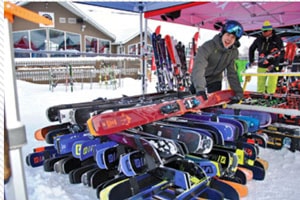SHOP TALK
“Rocker,” “camber,” “playful,” “float,” “taper”…does all the lexicology in ski gear sometimes leave you confused but nodding in agreement? Here’s a glossary of some basic jargon that goes along with ski shopping.

EARLY RISE in the tip and tail is about moving the contact point of the ski with the snow surface toward the centre. Old-school straight skis touched down just below the tip and continued right through to the end of the tail. Almost all skis now have at least a little early rise in the tip. In other words, if you laid the skis on a table the tip would extend back a ways toward the binding.
What it does: Early rise in the tip encourages a ski to rise to the surface in fresh snow, making it easier to ski powder. It also helps with turn initiation, encouraging the ski to get on edge as the ski is flexed. Meanwhile, early rise in the tail makes it easier to release the ski from a carve. This is good for skidding turns on the steeps and for faster transitions between turns. Combining early rise tip and tail make a ski feel shorter without losing surface area, so it’s more nimble and manoeuvrable.
CAMBER, the arch of the ski, comes in three options: cambered, full rocker or flat.
CAMBERED: This is the most common and traditional way to build a ski. The ski arches up from the tip and tail to the highest point right under the binding.
What it does: Camber is like a spring. Pushing it into the snow creates the power and bite for digging edges into hard snow, and releasing the bend creates energy and pop into the next turn. The more camber the more bite and pop.
FULL ROCKER: Also known as reverse camber, these powder-specific skis only touch the snow right under the foot. The rest of the ski arcs up (think barrel stave) instead of the more typical downward bow. What it does: Full rocker is all about float. These skis pivot super easily and want to surf on the surface of fresh snow. They release easily in a turn for smearing and playful fun. However, without any camber they lack the pop and hard-snow bite.
FLAT: These skis have no arch, sitting flush to the snow from tip to tail. What it does: Flat skis are more playful than cambered skis, but with sidecut they retain some ability to carve.
SIDECUT is the shape of the ski from tip to waist to tail. Typically the arc is smooth across the ski’s length, but many brands combine different arcs along a sidecut to add multiple turning behaviours in one ski. What it does: In general, more shape encourages a ski to make tighter turns. Conversely, less sidecut creates a ski that prefers big turns. More width throughout the ski increases the surface area so the ski floats higher in powder, while less width is easier to swing from edge to edge, turn to turn.
TAPER: Rather than the widest point of the ski being at the tip and tail, a tapered ski shifts the wide point toward the binding, usually by a few centimetres.
What it does: Tapering removes material from the ends of the ski, lightening up the tip and tail and reducing swingweight, or the energy required to turn a ski. It also increases how loose and playful a ski feels.
FLEX is how easy it is to bend a ski relative to a skier’s weight. Manufacturers play with flex at the tip, centre and tail of a ski and use three subjective measures, soft, medium and stiff at each point. What it does: Altering flex at each of the three points in a ski determines how it performs. Most people pick a ski that’s stiffer than needed. In general, soft is forgiving and stiff is stable.
Tip: A soft tip makes it easy to initiate a turn and absorb bumps. A stiffer tip provides bite, great for hard-snow carving and stability at speed.
Centre: A soft centre provides a forgiving ride that’s easy to turn. A stiff centre feels stable at speed, even if the tip and tail are soft.
Tail: A soft tail feels loose and buttery. A stiff tail adds snap and pop at the exit of a turn. It also provides a good platform for landing jumps and skiing in uneven terrain.
SIDEWALL is the part of the ski between the edge and the topsheet. There’s a ton of variety in sidewall construction, but typically it tapers from thickest under the binding to thinnest at the tip and tail. What it does: Sidewall plays a roll in a ski’s flex. A full sidewall from tip to tail adds stiffness and edge bite. Sidewall construction also plays a roll in durability, since this is the part of the ski that receives the most impact and holds the rest of the sandwich of materials together.
DAMPNESS is a ski’s ability to absorb vibrations. The damper a ski, the better it bites into the snow and consequently holds an edge through a carve.
PLAYFUL is an ambiguous term generally associated with a ski’s loose tail and snappy feel. Mostly appreciated by people who don’t feel the need to make perfect turns, but it’s often described in freeride and park skis.
MATERIALS
Carbon strands, stringers or sheets are added to a ski for varying reasons, but mostly for its lightweight stiffness. Carbon can act as a dampening agent and stiffens a ski for edge bite and stability.
Metal, most commonly Titanal, adds some stiffness but mostly dampening or vibration absorption.
Wood cores are the gold standard in skis; we’d hesitate to buy a ski without a wood core. Usually strips of different types of wood are laminated together to find a trade-off between different performance attributes.
by RYAN STUART in Buyer’s Guide 2019 issue